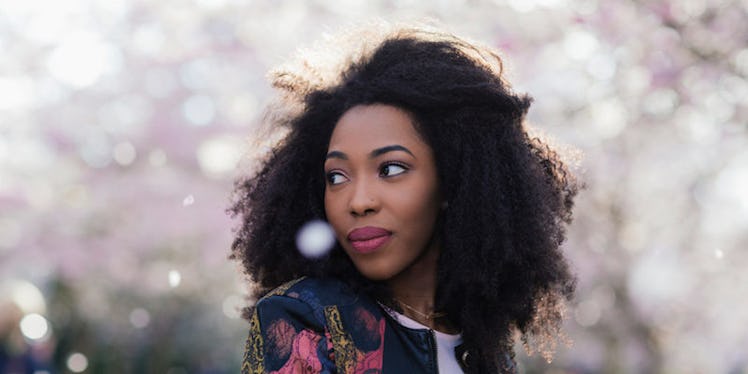It would take a lifetime for me to achieve Teyonah Parris' outstanding mane, but that hasn't stopped me from trying. This past August, I accidentally destroyed my locks attempting to darken my hair. I wanted to match Parris' voluminous, ebony coif.
I followed the instructions to the letter, slipping on the one-size-fits-no-one gloves and dousing my hair in dye. Unfortunately, my puffy curls were too fragile for the permanent chemicals. The dye left my hair dried out and broken, and I only made it worst by straightening my natural kinks to cover the damage.
It was painful to watch two years of hair growth quite literally wash down my tub's drain. At first, I panicked. Then, I consulted a hair stylist who gave it to me straight: I'd thoroughly f*cked up my hair.
When I went natural, the decision created an intimate relationship between me and my strands. I knew which products would transform my overnight twist-out into a luxurious, puffy 'fro and which serums would guard my locks from heat damage.
Still, I was unaware of how drastically a botched dye job could change my texture, beauty regimen and everything I thought I knew about my hair. Not to mention, my confidence took a blow, but that's a story for another day.
Today, I'm still fighting to regain my full-bodied hair by living by a strict restorative routine. Here's what's worked for me so far.
Figure out whether your hair needs protein or moisture.
Before the dye ruined my life my hair, I treated my mane like a succulent. My hairstyles took minimal manipulation and I never had to layer on a bunch of product.
But, as my hair started falling out, I obsessed over finding a mane regimen that worked. Though my hair products said "moisture," my strands were drier than ever. I was using products with strengthening formulas, like DevaCurl, which provided my hair with more protein than I needed and left me with rough, brittle hair.
DevaCurl Kit For All Curl Kind, $22, Amazon
Because my thick hair is naturally fortified with keratin, I needed to balance it out. Now, I rely heavily on coconut oil and a Moroccanoil Intense Hydrating Mask to help rebuild my broken ends. I also use leave-in conditioners to lock in moisture.
Moroccanoil Intense Hydrating Mask, $16, Sephora
Drink more water and pack your diet with vitamin E.
At the time, I was drinking less than six glasses of water a day, which was dehydrating my body and my follicles. Like a plant, my scalp needed the water every day to maintain good circulation and replace my damaged strands with healthy, strong hair.
However, water alone didn't repair my tresses. I broadened my eating habits and consumed more vitamins from fruits and veggies. Avocados, broccoli and spinach are rich in vitamin E and biotin, which help restore damaged hair. I can't even tell you how much guacamole I eat.
Chop those damaged strands off.
I refused to get my hair cut, even while I watched my hair fall out of my head every time I washed it. I clung to the length that dipped slightly below my shoulders. Eventually, though, I needed a trim more than Drake needs Rihanna.
Cutting unhealthy hair and split ends leads to fuller, shinier hair growth. The cut won't make your hair grow faster, but does make for strong, healthy hair. I can run my fingers through my hair at work and not be terrified I'll leave a pile of strands on my desk.
Whether it's pulled back into a ponytail or worn down, my hair is an extension of who I am. It is my queenly crown and should never remain damaged. Who doesn't want their hair to be its healthiest?
Through a series of restorative measures, my hair has bounced back from its brittle season. It'll be back to its full glory by summer, just in time for me to stunt for the 'gram.
